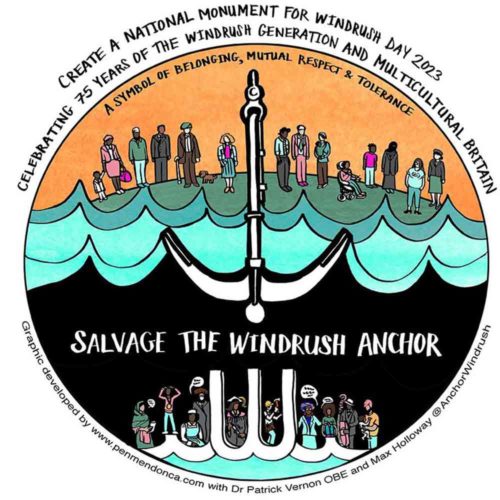Windrush activist Patrick Vernon OBE has launched a fundraising drive to further the campaign to raise the anchor of the Empire Windrush. It would become the centrepiece of a monument to the Windrush Generation and their descendants.
The campaign, which began on Windrush Day (22 June) last year at Brixton’s Black Cultural Archives (BCA), aims to find the wreck of the Empire Windrush where she sank in the Mediterranean and recover her stern anchor.
The anchor is at the centre of one of the iconic images of the arrival at Tilbury of the ship and her passengers from the Caribbean and elsewhere on 22 June 1948.
Campaigners hope to have the monument completed by Windrush Day 2023, which will be the 75th anniversary of this event.
“This will be a people’s memorial, symbolic of the vital role the Windrush Generation, their children and grandchildren have played in creating a prosperous, multicultural British society,” said Patrick Vernon.
He is the independent race equality and diversity advisor to Lambeth council, appointed jointly by the council and trade unions representing its staff to support the council in taking forward its equality, diversity and inclusion agenda.

A child of the Windrush Generation, Vernon led the successful campaign to establish 22 June as Windrush Day – a national day acknowledging the migrant contribution to UK society.
He said the monument would be placed in a prominent location chosen by the public after extensive consultation.
The anchor lies some 2,800 metres (more than one and a half miles) deep, about 23 miles off Algeria.
The Windrush, whose story is a history book in itself, was used after its famous Caribbean voyage to carry military personnel and their families back to the UK from the Far East.
In February 1954, on one of these voyages, the engine room caught fire, killing four workers. The remaining 1,494 people on board were saved. The abandoned ship, still on fire, was being towed to Gibraltar when she sank two days later.
The major costs of the project to raise the anchor would come from hiring specialist search and recovery vessels. They could range from £1.5 to £2.5 million.

The campaign is seeking to raise an initial £500,000 that it expects would be matched and added to by major benefactors and corporate sponsors.
As well as Patrick Vernon, others involved in the campaign are MAST, a charity led by Jessica Berry, an award-winning maritime archaeologist, that investigates and protects Britain’s maritime heritage.
The charity operates a maritime archaeological facility where Windrush’s 1.5-tonne anchor would be conserved by a process that would take about a year.
MAST would also develop an educational and outreach programme focusing on the maritime history of the Empire Windrush and her role in the story of the Windrush Generation.
David L. Mearns, one of the world’s most experienced and successful deep-sea wreck hunters, has agreed to lead the search. He has located 25 major shipwrecks with a success rate of 90% and has five Guinness World Records, including one for locating the deepest shipwreck ever found at 5,762 metres.
He found the wreck of HMS Hood, the British warship sunk by the German battleship Bismarck in WWII, and was later recovered its bell, which was donated to the National Museum of the Royal Navy in Portsmouth where it has been viewed and touched by countless relatives of victims of the Hood sinking and other visitors.
“I have seen first-hand how important a physical object, like the bell of HMS Hood, can be in connecting people to the memory of a ship and her crew,” he said.
“I am in no doubt that Windrush’s anchor will become a similar ‘touchstone’ for the Windrush Generation and the wider public.”
Max Holloway is a visual communicator who began researching the Empire Windrush and its iconic anchor in 2016. His late wife, Alice, was of Caribbean heritage and her parents settled in Britain in the late 1950s.
Inspired by Alice’s spirit of positivity he views the Windrush Anchor Monument as a small gesture, but one that should invite personal connectivity and ignite the national conscience.






